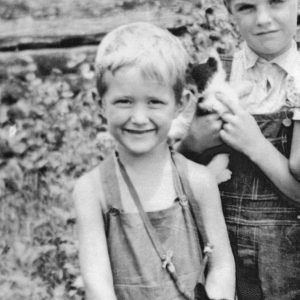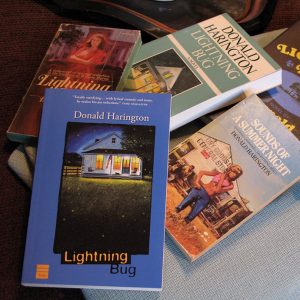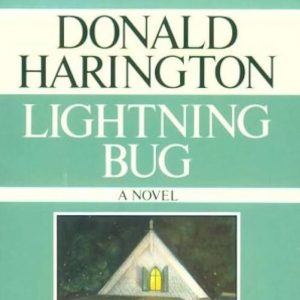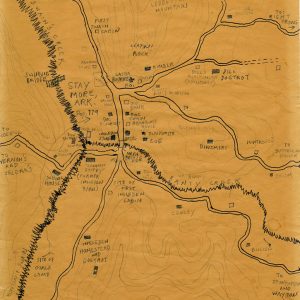calsfoundation@cals.org
Donald Harington (1935–2009)
Donald Douglas Harington was described by Entertainment Weekly as “America’s greatest unknown writer.” He published more than fifteen books that brought him critical recognition but little in the way of commercial success. His novels, usually set in the fictional Ozark town of Stay More, make up an interconnected body of fiction not unlike William Faulkner’s works about Yoknapatawpha County. Critics have seen in his work the influences of other major world writers such as Gabriel García Márquez and Vladimir Nabokov. In his works, Harington combined the folklore and folk life of the Ozark region with modernist and postmodernist techniques to create works that mix sex, comedy, and violence.
Donald Harington was born on December 22, 1935, in Little Rock (Pulaski County) to Conrad Fred Harington and Jimmie Walker Harington. He was a middle child, with an older brother and younger sister. He grew up in the city but spent summers with his maternal grandparents in Drakes Creek (Madison County), where they ran the general store and post office. Drakes Creek later provided the inspiration for the town of Stay More (called “Stick Around” in some books). When Harington was twelve, he contracted meningococcal meningitis and lost most of his hearing.
Harington attended the University of Arkansas (UA) in Fayetteville (Washington County), graduating with a BA in art in 1956 and an MFA in 1958. In 1957, he married Nita Harrison; they had three daughters. He received an MA in art history at Boston University in 1959. He started the doctoral program in art history at Harvard the following term but abandoned it after a year.
Harington taught art history at Bennett College in Millbrook, New York, from 1960 to 1962 and then at Windham College in Putney, Vermont, from 1964 until 1978, when the college closed. While at Windham, he published his first novel, The Cherry Pit (1965), in which a Boston curator of Americana leaves his wife to immerse himself in his lost Little Rock past. Lightning Bug (1970), his first Stay More novel, was dedicated to Harington’s mentor and friend William Styron. It tells the story of Latha Bourne, the postmistress of Stay More, and how she deals with the return to town of Every Dill, the man who raped her ten years earlier. Harington’s next book, Some Other Place. The Right Place. (1972) is a sprawling tale of sex and reincarnation that is also probably one of his most autobiographical works. The story moves from the rural northeastern United States to the Arkansas Ozarks, told in part by a narrator who is a washed-up professor of art history at a small college in Vermont. The Architecture of the Arkansas Ozarks (1975) is considered by many to be the seminal work of Harington’s Stay More corpus. Illustrated by the author, it relates the history of the town and its people—from the time of its founding by Jacob and Noah Ingledew—by reflecting upon the evolution of its architecture from a thatched hut, to a tree house, to an “im-mobile home.” The American Library Association listed the book as one of the year’s ten best novels.
Windham College closed in 1978, and soon afterward Harington and his wife were separated and then divorced. Harington began a long descent into depression and alcoholism, and the succession of short-term teaching appointments he had during the next few years—at the University of Missouri–Rolla, the University of Pittsburgh, and South Dakota State University—only made matters worse. Too, he found himself unable to finish his next book. Harington moved back to Arkansas in 1981 and began teaching art history at his alma mater in 1986. The story of his return to Arkansas is the basis of Let Us Build Us a City: Eleven Lost Towns (Harcourt Brace Jovanovich, 1986). In it, an alcoholic art history professor named Harrigan, teaching in South Dakota, receives a letter from a woman named Kim (the real-life Kim McClish), who has been inspired by Harrigan’s novels to seek out the ghost towns of Arkansas and interview their residents; Kim asks him to collaborate with her on this project. Let Us Build Us a City was critically very well received. The following year, Harington was awarded the Porter Prize for Literary Excellence.
Shortly after their trip across Arkansas, Harington and McClish were married. With his wife’s help, he overcame both alcoholism and writer’s block. He was appointed to the faculty of the art department of UA in 1986. Over the next decade, he wrote four new novels (all published by Harcourt Brace) and one work of art criticism. The Cockroaches of Stay More (1989), in part a satirical religious parable, is told from the point of view of Stay More’s cockroaches. The plot of The Choiring of the Trees (1991), about an attempt to save a falsely convicted rapist from execution, was inspired by an essay judged by Harington for a contest of the Pulaski County Historical Society. Ekaterina (1993) is a re-imagining of Vladimir Nabokov’s Lolita featuring an émigré from Eastern Europe who has a sexual desire for prepubescent boys. Butterfly Weed (1996)—which was, according to Harington, a tribute to another of his idols, Vance Randolph—is a tall and bawdy tale about a love triangle involving Stay More’s Doc Swain. On a Clear Day: The Paintings of George Dombek, 1975–1994 (published by the University of Central Arkansas Press in 1995), is an analysis of the Arkansas artist’s watercolors.
Again, despite critical acclaim and a devoted fan base, commercial success—and a regular publisher—eluded the author. Harington’s next book, When Angels Rest (Counterpoint, 1998), is set in Stay More during World War II. Thirteen Albatrosses (or, Falling off the Mountain) (Henry Holt, 2002), recounts Vernon Ingledew’s campaign for the position of governor of Arkansas against incumbent Shoat Bradfield, despite the “thirteen albatrosses” that hang about his neck, such as his atheism, the fact that he lives in sin with his first cousin, and his desire to get rid of hospitals and schools.
Having gone through eight “different indifferent” agents in his career, Harington sent his next novel, With, to the Toby Press, a publisher he found online after numerous rejections. Toby Press published the novel in 2003 and soon began to reissue many of Harington’s previous works. With tells the story of Robin Kerr, a young girl kidnapped by a former state trooper who takes her to a remote mountain outside of Stay More. After he dies, she is forced to survive in the backwoods and develops an imaginative world in which she communes with animals and ghosts. In 2005, Harington published The Pitcher Shower, an Ozark riff on Shakespeare’s A Midsummer Night’s Dream. That same year, he published an “imaginary autobiography” of Arkansas-born artist Carroll Cloar in the Oxford American, a portion of which had been published in 2003 in the Arkansas Times. In 2008, he published Farther Along, a novel about a museum curator who takes up residence in the Ozark wilderness to escape civilization. The following year, he published Enduring.
Harington was inducted into the Arkansas Writers Hall of Fame in 1999 and won the Robert Penn Warren Award for fiction in 2003. He was awarded the Porter Prize Lifetime Achievement Award in 2004. He retired from UA in 2008. On November 7, 2009, he died from complications of pneumonia. In 2020, the University of Arkansas Press released Double Toll and Trouble, featuring previously unpublished fiction by Harington.
For additional information:
Arnold, Edwin T. “Interview: Donald Harington.” Appalachian Journal 21 (Summer 1994): 432–445.
Blad, Evie. “Harington, Writer Who Focused on Life in Ozarks, Dies at 73.” Arkansas Democrat-Gazette, November 10, 2009, pp. 1B, 8B.
Brockmeier, Kevin. “Five Glimpses of Donald Harington.” Oxford American 100 (Spring 2018): 112–115. Online at https://oxfordamerican.org/magazine/issue-100-spring-2018/five-glimpses-of-donald-harington (accessed May 8, 2024).
Donald Harington Special Issue. Southern Quarterly: A Journal of the Arts in the South 40 (Winter 2002).
Grimes, Williams. “Donald Harington, Ozark Surrealist, Dies at 73.” New York Times, November 12, 2009. http://www.nytimes.com/2009/11/12/arts/12harington.html?_r=1&scp=2&sq=arkansas&st=cse (accessed October 18, 2021).
Keller, Christoph III. “Homily for Harington.” Arkansas Democrat-Gazette, October 17, 2021, pp. 1H, 6H. Online at https://www.arkansasonline.com/news/2021/oct/17/homily-for-harington/ (accessed October 18, 2021).
Koch, S. “A Wonderful Team: Novelist Donald Harington’s ‘Autobiography’ of Late Artist Carroll Cloar Waits to See the Light of Day.” Arkansas Times, March 14, 2003, pp. 10–11.
Razer, Bob. “Donald Harington and His Stay More Novels: A Celebration of Thirty-Five Years.” Fayetteville: Special Collections Department, University of Arkansas Libraries, 2006.
Reed, Steve. “Donald Harington: Wry Stories and Word Music from Unexpected Places.” Arkansas Democrat-Gazette, May 12, 1996.
Vonalt, Larry. “An Interview with Donald Harington.” Chicago Review 38 (Winter 1993): 60–77.
Walter, Brian, ed. Double Toll and Trouble: A New Novel and Short Stories by Donald Harington. Fayetteville: University of Arkansas Press, 2020.
———. The Guestroom Novelist: A Donald Harington Miscellany. Fayetteville: University of Arkansas Press, 2019.
Stephen Koch
“Arkansongs”
Staff of the CALS Encyclopedia of Arkansas



 The Architecture of the Arkansas Ozarks
The Architecture of the Arkansas Ozarks  Harington Architectural Drawings
Harington Architectural Drawings  The Cherry Pit
The Cherry Pit  The Cockroaches of Stay More
The Cockroaches of Stay More  Donald Harington
Donald Harington  Young Donald Harington
Young Donald Harington  Harington Books
Harington Books  Donald Harington
Donald Harington  Lightning Bug
Lightning Bug  Some Other Place. The Right Place.
Some Other Place. The Right Place.  Some Other Place. The Right Place.
Some Other Place. The Right Place.  Stay More Map
Stay More Map  Thirteen Albatrosses by Donald Harington
Thirteen Albatrosses by Donald Harington 



Comments
No comments on this entry yet.